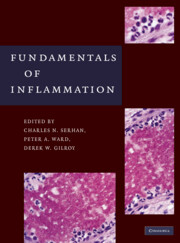Book contents
- Frontmatter
- Contents
- Contributors
- Preface
- PART I THE INFLAMMATORY RESPONSE – AN OVERVIEW
- PART II INDIVIDUAL CELL TYPES
- PART III CHEMICAL MEDIATORS
- 12 Lipid Mediators in Acute Inflammation and Resolution: Eicosanoids, PAF, Resolvins, and Protectins
- 13 Cytokines and Chemokines in Inflammation
- 14 Adenosine Receptors: Therapeutic Aspects for Inflammatory and Immune Diseases
- 15 Leukocyte Generation of Reactive Oxygen Species
- 16 Cell Adhesion Molecules
- PART IV IMMUNOPHARMACOLOGY
- PART V INFLAMMATORY DISEASES/HISTOLOGY
- PART VI ANIMAL MODELS OF INFLAMMATION
- Index
- References
12 - Lipid Mediators in Acute Inflammation and Resolution: Eicosanoids, PAF, Resolvins, and Protectins
from PART III - CHEMICAL MEDIATORS
Published online by Cambridge University Press: 05 April 2014
- Frontmatter
- Contents
- Contributors
- Preface
- PART I THE INFLAMMATORY RESPONSE – AN OVERVIEW
- PART II INDIVIDUAL CELL TYPES
- PART III CHEMICAL MEDIATORS
- 12 Lipid Mediators in Acute Inflammation and Resolution: Eicosanoids, PAF, Resolvins, and Protectins
- 13 Cytokines and Chemokines in Inflammation
- 14 Adenosine Receptors: Therapeutic Aspects for Inflammatory and Immune Diseases
- 15 Leukocyte Generation of Reactive Oxygen Species
- 16 Cell Adhesion Molecules
- PART IV IMMUNOPHARMACOLOGY
- PART V INFLAMMATORY DISEASES/HISTOLOGY
- PART VI ANIMAL MODELS OF INFLAMMATION
- Index
- References
Summary
INTRODUCTION
Autacoids are locally acting substances that are rapidly biosynthesized in response to specific stimuli, act quickly, and are usually deactivated by metabolism. Eicosanoids are a chemically diverse family of arachidonic acid–derived autacoids that have critical roles in cardiovascular, inflammatory, and reproductive physiology. Pharmacologic interventions in eicosanoid pathways – including the nonsteroidal anti-inflammatory drugs (NSAIDs), COX-2 inhibitors, and leukotriene inhibitors – are useful in the clinical management of inflammation, pain, and fever. Given the many important bioactivities of lipid mediator eicosanoids, resolvins, and protectins, future research may lead to the development of new therapeutics for the treatment of inflammatory conditions, autoimmune diseases, asthma, glomerulonephritis, cancer, sleep disorders, and Alzheimer's disease.
BIOSYNTHESIS OF EICOSANOIDS
Eicosanoids are crucially involved in a number of metabolic pathways that have diverse roles in inflammation and cellular signaling. These pathways center on reactions involving the metabolism of arachidonic acid (Figure 12.1). The following considers the biochemical steps leading to arachidonic acid synthesis, then discusses the cyclooxygenase (COX), lipoxygenase (LOX), epoxygenase, and isoprostane pathways of arachidonic acid metabolism. Arachidonic acid (cis-, cis-, cis-, cis-5, 8, 11, 14-eicosatetraenoic acid), the common precursor to eicosanoids, must be synthesized from the essential fatty acid precursor linoleic acid (cis, cis-9, 12-octadecadienoic acid), which can be obtained only from dietary sources. In cells, arachidonic acid is esterified to the sn 2 position of the membrane phospholipids predominantly in phosphatidylcholine phosphatidylethanolamine, and phosphatidyl inositol.
- Type
- Chapter
- Information
- Fundamentals of Inflammation , pp. 153 - 174Publisher: Cambridge University PressPrint publication year: 2010
References
- 10
- Cited by



